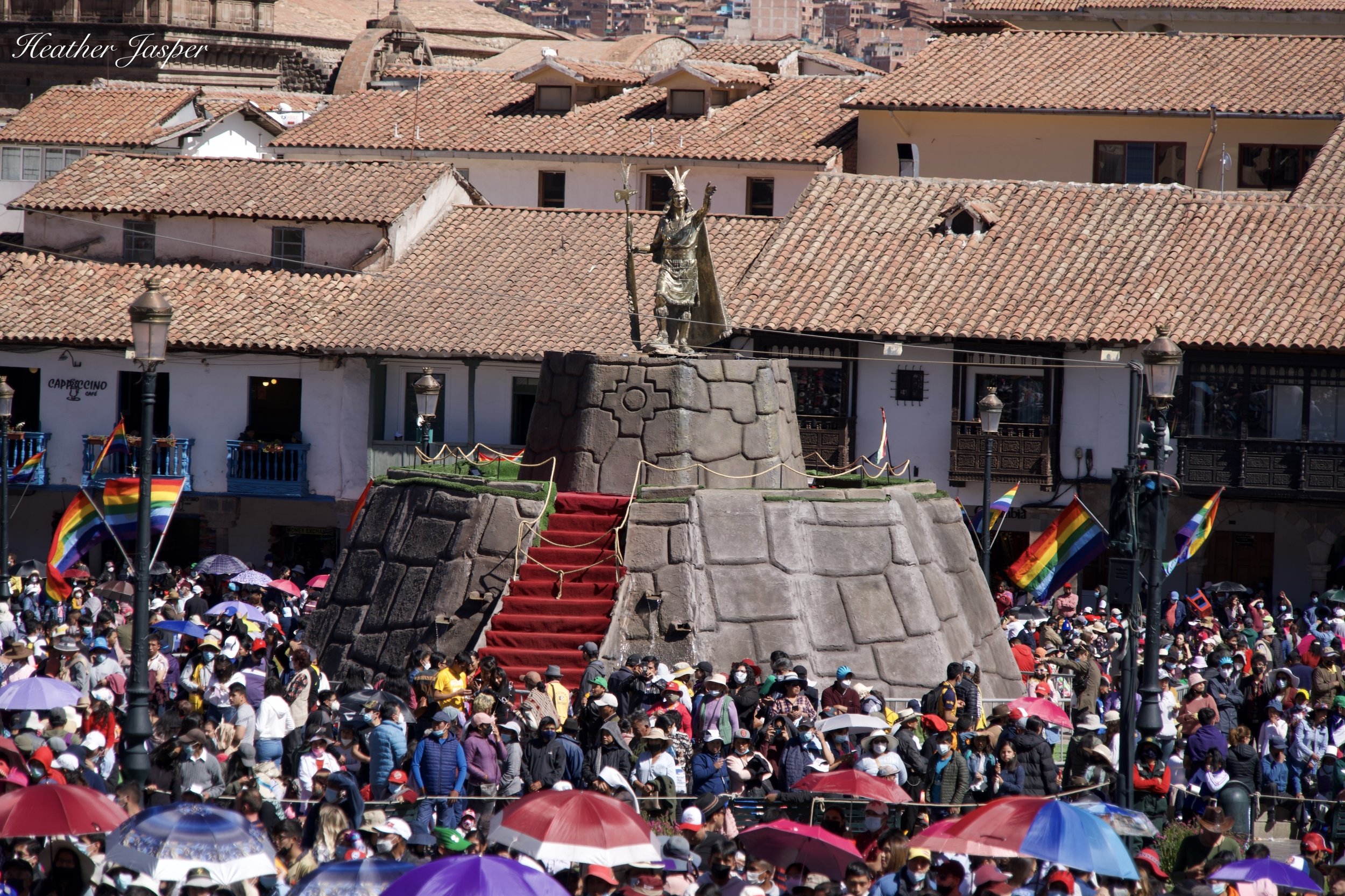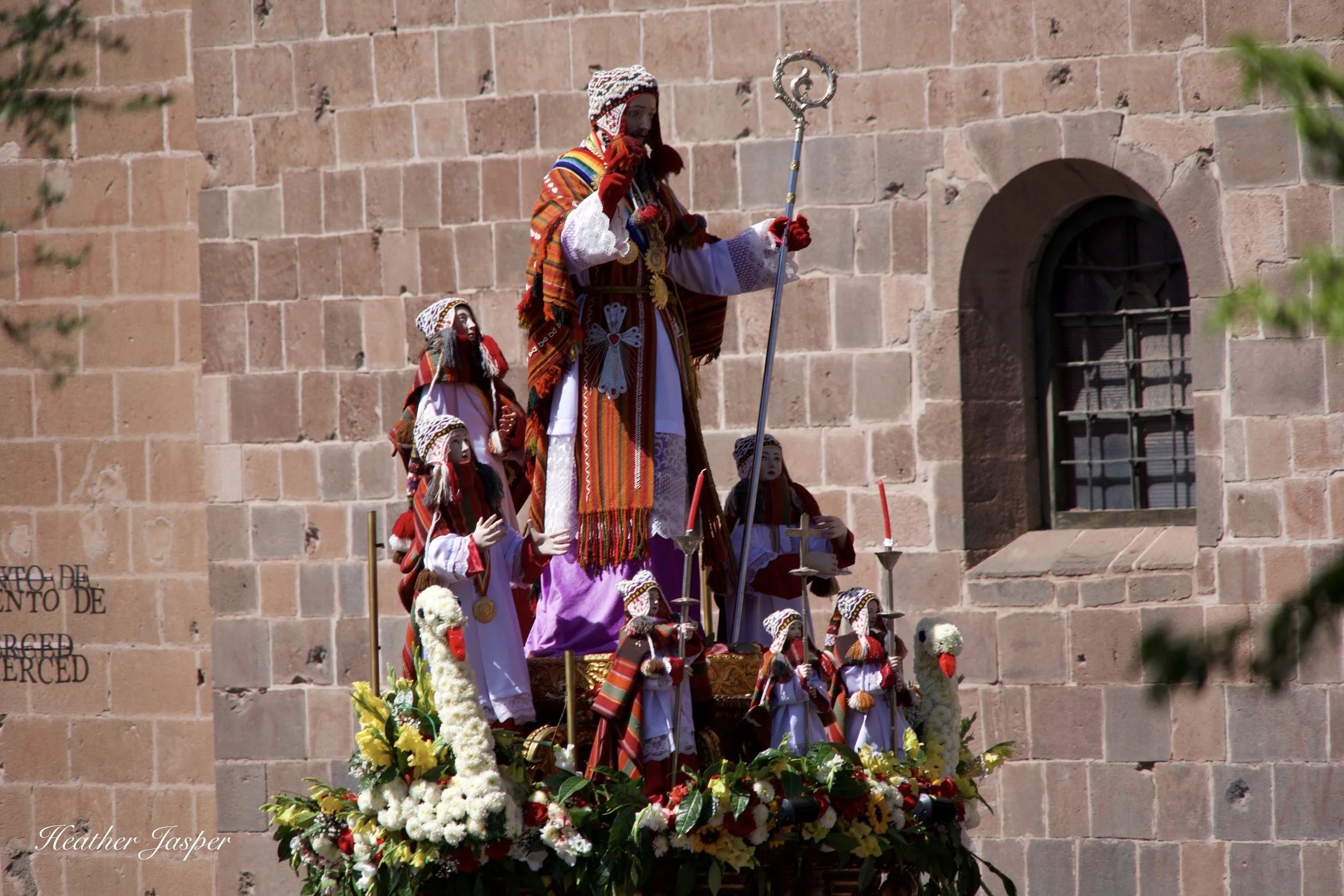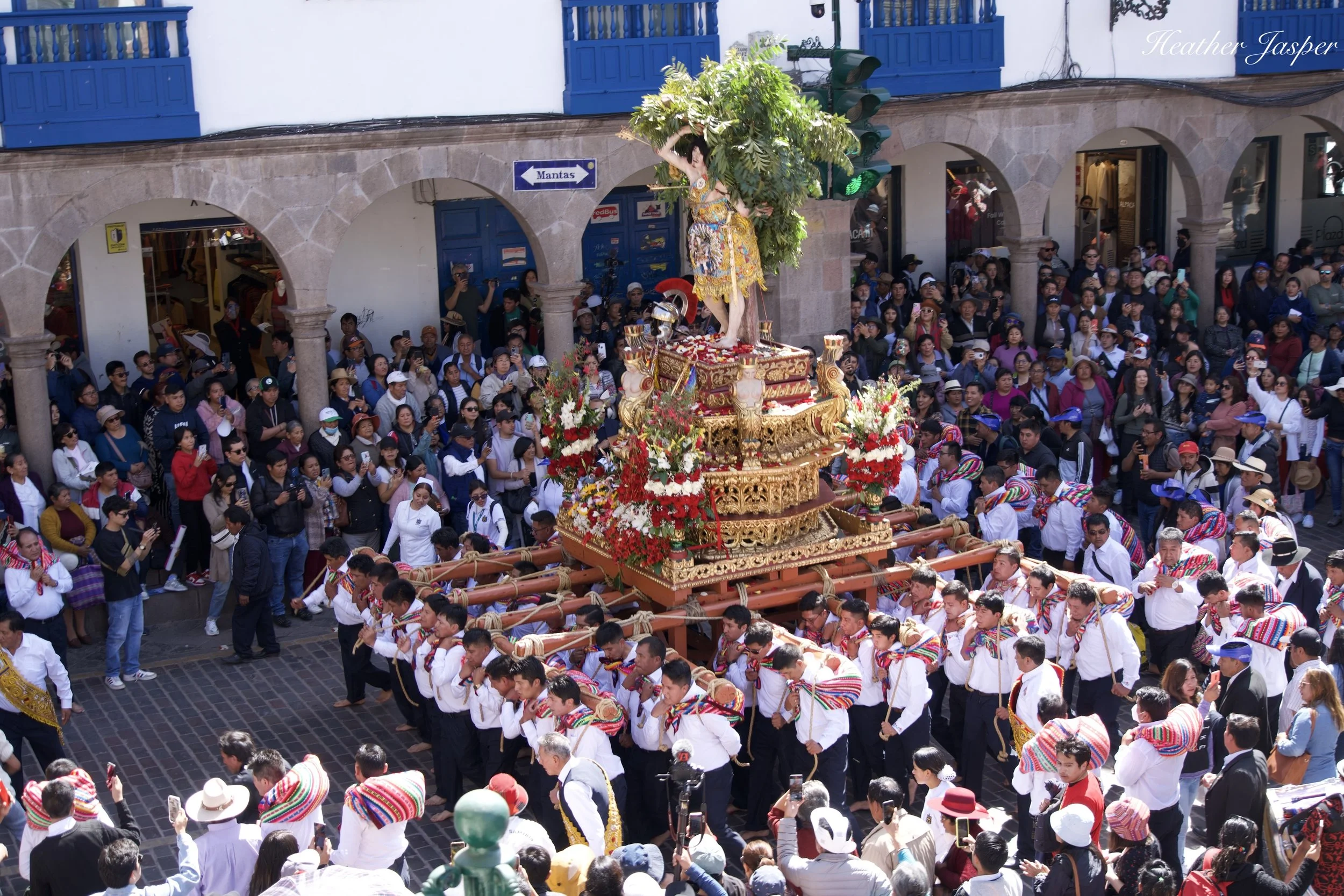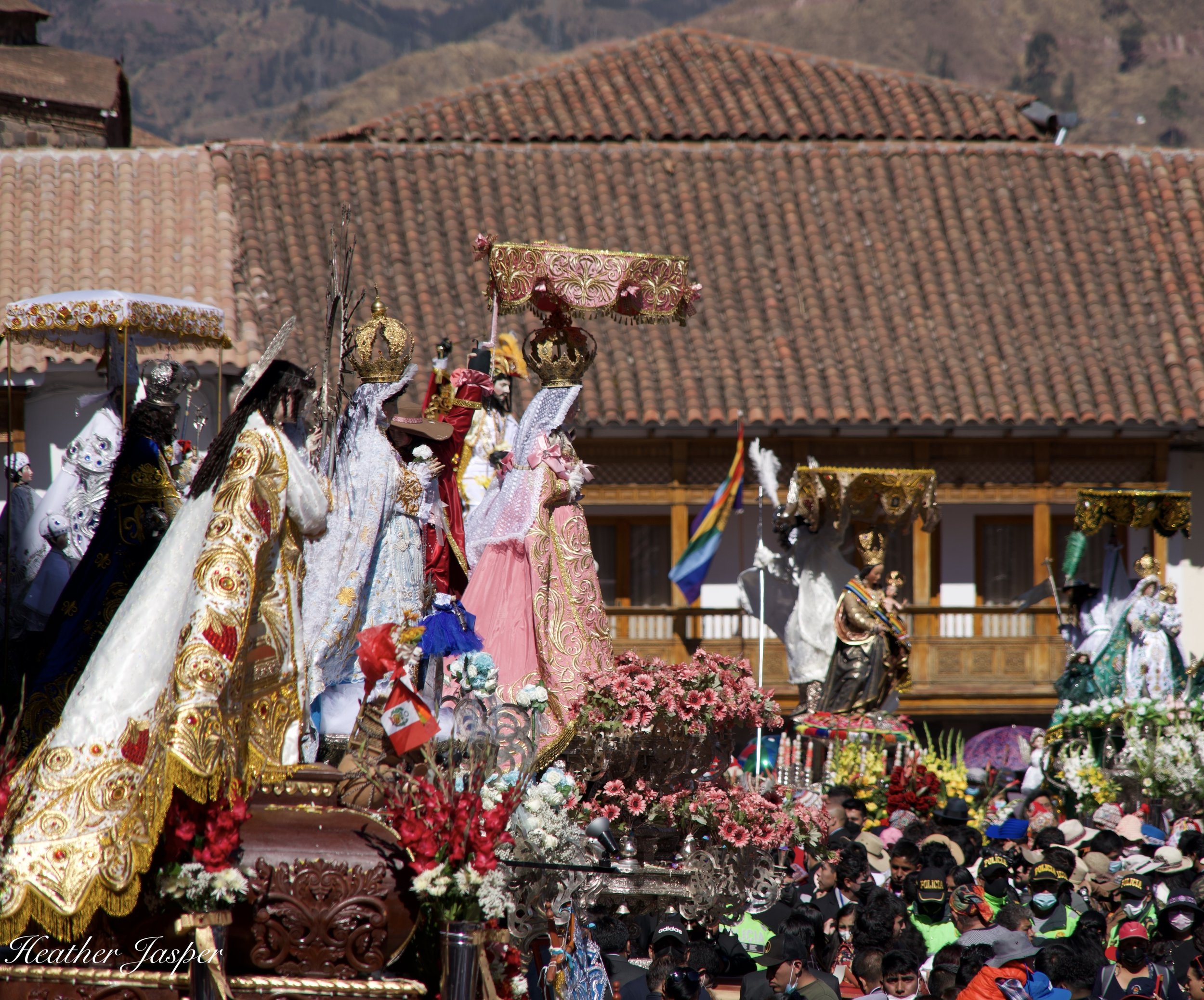Cusco’s Corpus Christi
Ask Cusqueños what their favorite holidays are and near the top of the list is always Corpus Christi. It’s the beginning of Cusco’s holiday season, which doesn’t end until Inti Raymi on June 24th.
On the right is the statue of Patrón Santiago, with the Virgin de los Remedios behind in green and the Virgin Natividad next to her in gold. The virgins have a round Inca parasol like the one the Qoya, the Inca’s wife, used to use. On the left are several other saints and virgins waiting their turn to parade around the plaza.
The most important days of Corpus Christi
Bajada de Corpus is two Sundays before Corpus Christi, Entrada de Corpus is the Wednesday before the main holiday and the official Corpus Christi celebration is always on a Thursday. The following days there are parades and dances in the plaza.
Cusqueños tend to be more religious, and more fervent, than most Peruvians. This may be a result of the Spanish effort to convert the people of Cusco more than others. As Cusco was the capital of the Inca’s territory, called Tahuantinsuyo, it was imperative to wrest control from the Inca politically, economically, culturally and spiritually. War, weapons and brutality could only win Cusco politically and in some ways economically. To get to the hearts and minds of Cusco, the Spanish had to replace all Incan tradition and celebrations with Catholic ones.
Before Corpus Christi, the colonial fountain under the statue of the Inca Pachacutec is covered with fake stonework, in preparation for Inti Raymi on June 24th. The statues of saints and virgins parade around the plaza, circling the Inca.
One way they did this was by destroying Inca temples and palaces, then building churches in their places. Cusco has an abundance or churches, bordering on a ridiculous number of churches, because there were so many Inca temples and palaces. (The Inca was the ruler of Tahuantinsuyo, and the people he ruled were called by the place and culture they belonged to. The Inca’s subjects who lived in Cusco were Cusqueñian, not Incan).
When an Inca died, his body was mummified and treated as if he were still alive. He retained ownership of his palaces, estates and agricultural lands. His mummy was given food daily, though likely his family members ate it after it sat in front of him for some period of time. He was also consulted when the current Inca needed advice. Each Inca’s mummy had an official advisor who communicated what the mummy of the Inca he served would advise.
San Blas and his entourage of altar boys wear Andean hats called chullo and traditional Andean ponchos during the first part of Entrada, on their way to the Iglesia de Santa Clara.
Throughout the year, mummies of previous Incas and perhaps other important people who were mummified, would be brought to the plaza, then called Awkaypata. They would participate in special rituals and ceremonies and in some cases were paraded around Awkaypata. The days leading up to winter solstice, now on June 21st, were full of special ceremonies.
Cusqueñians were used to lots of ceremonies, celebrations and holidays. If the Spanish were to win over the hearts and minds of any Cusco residents, they had to outdo the Inca. In the beginning, they settled on destruction: burning mummies and dismantling palaces and temples. Eventually, as war became colonization, they had to change tactics and create their own celebrations and holidays to compete with the Inca celebrations that they had forbidden.
Each statue is accompanies by dancers and groups from the neighborhood around the saint or virgin’s church. San Blas was accompanies by several dance groups, plus the San Blas artists’ association.
The way Corpus Christi is celebrated in Cusco is unlike anywhere else in the world.
Bajada de Corpus
Today, two Sundays before Corpus Christi, one saint and one virgin are brought to the Santa Clara church, where they wait for Entrada. San José, who represents Joseph, the husband of the virgin Mary and the Virgen de Belén are both brought from Iglesia de Belén. This is a procession of about 1.5km from the church to the Plaza de Armas.
Centuries ago, saints were brought from other parts of what used to be Tahuantinsuyo, the Inca’s territory. I don’t have exact dates but believe it was in the 1700s and 1800s. The Virgin Purificada came from Copacabana, Bolivia. Santo Tomás Apóstol came from Tucumán, Argentina. La Virgin de la Asunción was brought from Quito, Ecuador. Others were brought from Chile and Ecuador, but I don’t have the names.
Each one would have been carried, making each procession several weeks walking each way. It’s entirely possible that the Spanish did this to supplant mummies of local rulers who were previously brought to Cusco for the Inca’s winter solstice celebrations.
About forty men carry San Sebastián, wearing traditional Andean wraps called lliclla. Many Peruvians still use lliclla as backpacks and to carry children.
Entrada de Corpus
The Entrada or entrance to Corpus Christi is on a Wednesday, when statues of saints and virgins are brought from the churches around Cusco to the plaza. When statues were brought from other cities and countries, Cusco’s statues would lead them to the plaza.
Today, Entrada is only fifteen saints and virgins from Cusco’s main churches. San José and the Virgen de Belén are already at the Santa Clara church, and the other thirteen statues are brought from around the city to Santa Clara. Most are brought to Santa Clara in clothing that represents traditional Andean outfits. Some wear colorful ponchos and chullos, a knit hat with flaps that cover the ears. At Santa Clara they are dressed in their finest silk and jeweled robes, then paraded to the cathedral on the Plaza de Armas.
The men who carry the saints and virgins (and so far I’ve only seen men carrying them), also change clothes. They come to Santa Clara dressed in traditional Andean outfits and leave in suits and ties.
The men who bear the statue of Santa Ana wear beaded chullo hats and wrap llicllas across their shoulders.
All these processions are hard work.
Every time one of these statues is moved, it’s perched on an elaborate throne of sorts, and carried on the shoulders of the faithful who are members of the church that it’s from. These are incredibly heavy, and people follow the statues with sturdy metal poles to set the statue on when they rest. The statues must stay at about shoulder level, because it would be next to impossible to set these down on the ground and pick them up again.
People in Cusco commonly say that each saint weighs a ton.
That’s 2,000 pounds or 907 kilos. Considering that each one is carried by around forty men, who are all clearly suffering, that doesn’t seem like an exaggeration to me. Over the past several years, I’ve watched these fifteen statues carried to the plaza and paraded around the plaza many times. Every one of them looks impossibly heavy. No matter how strong the men who carry them look, they are staggering under the weight.
Facing the Inca
Santa Barbara, above, starts her procession around the plaza at the front of the cathedral. When a statue gets to the bottom of Cuesta del Almirante, it’s turned to face the statue of the Inca. The bearers pause to rest there, with metal supports holding the weight of the saint’s throne, before they turn their statue to face the right and continue on the procession around the plaza. Below, San Cristobal carrying baby Jesus begins his procession around the plaza and stops to face the Inca. Below him, San Jerónimo on his horse does the same.
Santa Ana at Entrada
Santa Ana is brought from Santa Clara down to the Plaza de Armas during Entrada. She carries her daughter Mary in her arms.
Santa Ana during Corpus Christi
Santa Ana has a much more elaborate outfit for her procession around the plaza the day after Entrada.
San Antonio de Abad
This is one of the most important saints in Cusco. The city’s main university is named after him and his statue carries a book in its left hand.
Virgin de los Remedios
This statue is the smallest of all the statues brought to Corpus Christi and clearly the lightest since there are so few bearers carrying her.
Procesión de Corpus
Corpus Christi is celebrated on Thursday of the second week after Pentecost. The bishop holds a mass in the morning, then around noon the procession begins. The saints and virgins of Cusco have spent the night in the cathedral and are brought outside to be paraded around the plaza.
The statues then go back in the cathedral until the Octava, 60 days after the Sunday of resurrection. This is celebrated with Andean dances, especially Pujilí. This is an Andean dance that gives thanks to the Pachamama (Mother Earth) for the harvests of the previous year. That also implies a kind of gratitude in advance for the coming harvests.
Where to watch Corpus Christi
While the main processions are in the Plaza de Armas, the saints come from all over the city. On the Wednesday of Entrada main streets like Avenida de la Cultura and Avenida del Sol are blocked off. Traffic is terrible. If you need a taxi, you should plan on getting where you want to go before 9am, then walking during the day.
During Entrada you can stake out a spot on Avenida del Sol or on the route from the Plaza de Armas up to Santa Catalina. This is mostly a pedestrian route with cafés and restaurants with balconies. My favorite spots for Entrada are at the top of the Avenida del Sol, at one of the balconies of the restaurant Jonas, or on the terrace of La Valeriana Cakeshop facing the Iglesia de la Merced. Another good spot is in Plaza San Francisco, on the steps near the Santa Catalina arch. You can get great photos and have some shade at any of those.
La Virgin Purificada
On the right, in red, is the Virgin Purificada, with an Inca parasol. This statue of the Virgin Mary, carrying baby Jesus, has the most jewels and precious stones of all Cusco’s religious statues.
La Virgin de Belén
In pink, with an Inca parasol, is the Virgin de Belén. She is the most popular statue of the Virgin Mary in Cusco because of her reputation for granting miracles to faithful Cusqueños.
The plaza is the best spot for the main processions on the Thursday of Corpus Christi.
Choose your spot wisely and bring a hat and sunscreen. The sun this time of year is strong, even though it’s cold in the shade.
My favorite spot in the plaza is on the stairs by the side entrance to the cathedral, where Cuesta del Almirante comes down from Plazoleta Nazarenas. You can get photos looking south with the door of the cathedral and the front of the Iglesia de la Compania in the background. Looking towards the plaza, you can get photos of the statues as they come by with the Inca and the cupola of La Merced in the background.
Reserve a spot on a balcony
If you want to sit on one of the balconies around the plaza or along the Avenida del Sol, you need to reserve several days in advance. I highly recommend this because if you’re down in the plaza you’ll get jostled by the crowd and you have to be constantly on guard for pickpockets.
Not everything is Catholic or Andean. These Majeño dancers represent the men who brought distilled sugar cane alcohol from the jungle plantations up to Cusco in the centuries before cars and roads existed.
Traditional food for Corpus Christi
Families traditionally prepare chiriuchu throughout the week of Corpus Christi. This is a platter with ten different foods, each cooked separately. Restaurants serve plates that have a bit of each of the ten ingredients. They are usually cooked early in the morning and served cold throughout the day.
First is roast cuy (guinea pig) that is stuffed with an Andean herb called huacatay and roasted whole. Second is dried mutton, which is replaced with alpaca in more traditional places. Third is a whole boiled chicken. Fourth are torrejas, an egg and flour batter mixed with vegetables and fried like a fritter. Fifth is roasted corn. Sixth is ccochayuyo, a kind of seaweed that’s dried and brought from the coast. Seventh is rachi rachi, a kind of fish egg that’s also brought from the ocean. They come attached together like tiny bunches of yellow grapes. Eighth is a whole round cheese. Ninth is sausage, usually made from pork. The last is a kind of chili pepper called rocoto, usually roasted but sometimes raw.
Below are a series of vendors that I saw during Corpus Christi, 2024. You can buy almost anything from street vendors in Cusco. There’s also a man who dresses as a gold Inca statue and is very popular with kids. He works the plaza in front of the Iglesia de la Merced on holidays and weekends year round.










































